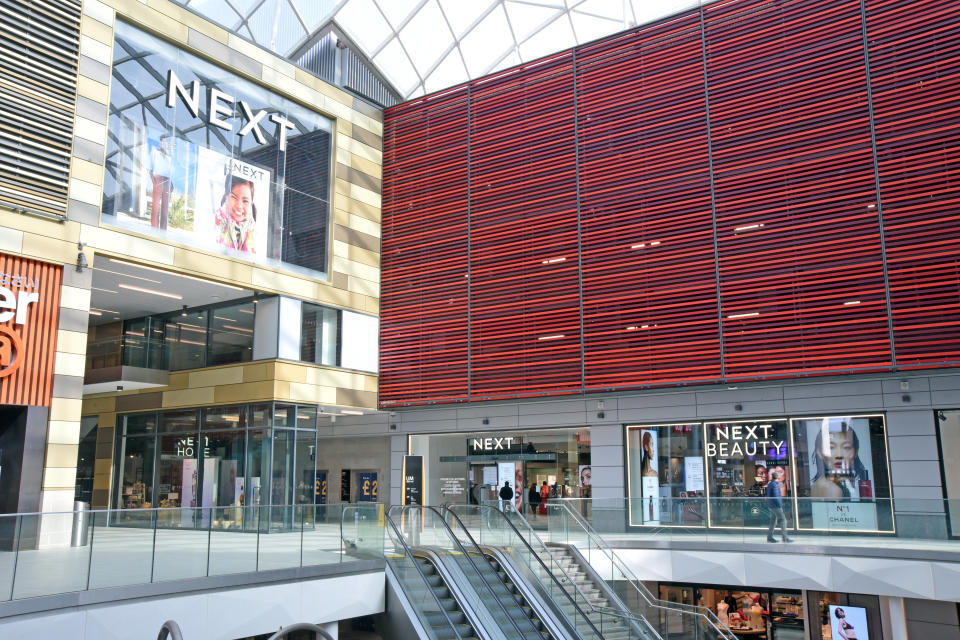Britain’s Next Says Online Slowing, Returning to Pre-pandemic Levels

LONDON — Next, one of the U.K.’s largest and most successful high street retailers, said online growth is slowing and returning to pre-pandemic levels, as shoppers flock to physical stores in the wake of the pandemic.
Next, which sells its own fashion, home and beauty collections, and operates a vast digital platform selling third-party brands, said in a trading statement Thursday that online trends have been “normalizing” after accelerating during lockdown.
More from WWD
It said sales in the first half were “dominated by a sharp reversal of last year’s lockdown trends.”

Courtesy image
Sales in physical stores have recovered while online growth “has reverted back to its longer-term trajectory.” It added that other lockdown trends are in retreat, including the craze for home and sporty clothing, while formalwear is on the rise.
In the second quarter ended July 30, online sales at Next edged up 0.2 percent year-over-year, while physical store sales were up 12 percent.
With regard to the online trends, Next pointed out that, in the first half, the compound annual growth rate for sales in the July 2019 through July 2022 period was 13.4 percent, compared with 12.6 percent in the three years between 2016 and 2019.
Next added that online return rates and surplus stock also reverted to pre-lockdown levels at 42 percent. During the pandemic, the retailer said it experienced two years of “exceptionally low returns rates” driven by product mix and the spike in popularity for low-return categories, like home, childrenswear and sportswear.
The trends at Next echo those at Shopify, which announced layoffs last week as online sales retreated post-pandemic.
Tobias Lütke, chief executive officer of Shopify, which services brands looking to sell online, said he believed the share of dollars that travels through e-commerce rather than physical retail “would permanently leap ahead by five or even 10 years,” due to the impact of the pandemic.
“What we see now is the mix reverting to roughly where pre-COVID-19 data would have suggested it should be at this point. Still growing steadily, but it wasn’t a meaningful five-year leap ahead,” he said last week after the company announced plans to cut 10 percent of its workforce.
Total full-price sales at Next rose 5 percent, including finance interest income, 50 million pounds ahead of its previous guidance. The company said it was the result of unusually warm and dry weather in June and July, and a marked return to formal dressing, possibly driven by the “pent-up demand for social events.”
The company, which is quoted on the London Stock Exchange and last year posted sales of 4.86 billion pounds, also raised its profit guidance for the year by 10 million pounds to 860 million pounds, 4.5 percent above last year’s levels.
The bump has come from better-than-expected full-price sales in the first half.

Next warned that the stronger-than-expected sales performance in the second quarter will likely not continue into the second half, and the company is maintaining its sales guidance for the remainder of the year at plus 1 percent.
The company is scheduled to release its first-half results on Sept. 29.
“Our caution stems from two factors, we believe that an unusually warm summer boosted sales in the first half, and we do not expect a similar weather windfall in the second half; and the impact of inflation on consumer spending is likely to worsen in the second half,” the company said.
Next, which also has stakes in high street brands including Reiss; a new joint venture with Gap Inc. in the U.K.; and exclusive distribution partnerships with Victoria’s Secret and Laura Ashley, certainly picked the right day to express its caution.
On Thursday, the Bank of England raised interest rates 0.5 percentage points to 1.75 percent to combat soaring inflation and a severe recession in the U.K. that’s expected to last through next year.
The Bank of England said inflationary pressures in the U.K. and the rest of Europe have “intensified significantly” since May, with a near-doubling in wholesale gas prices owing to Russia’s restriction of gas supplies to Europe and the risk of further curbs.
As a result, energy prices are set to soar in the fall, putting pressure on households.
U.K. Consumer Price Inflation is expected to rise to just over 13 percent in the fourth quarter, and will remain “at very elevated levels” throughout much of 2023, the Bank said.
At the same time, GDP growth in the U.K. is slowing, with the country projected to enter a recession from the fourth quarter of 2022.
Sign up for WWD's Newsletter. For the latest news, follow us on Twitter, Facebook, and Instagram.

